Suzuki Grand Vitara: Lighting/Turn Signal Control Lever
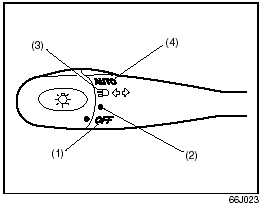
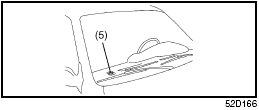
Your vehicle’s lighting system is controlled by three main systems: the Lighting switch, the Auto-On Headlight System (when the lighting switch is in the “AUTO” position) and the Daytime Running Light (D.R.L.) system. The three systems work together to operate your lights as shown in the following chart:
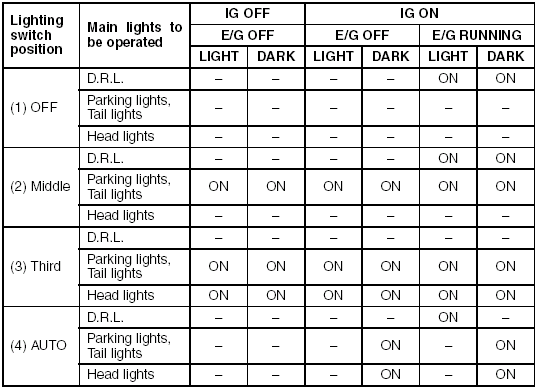
E/G: Engine IG: Ignition switch ON: Lights ON LIGHT: When it is light around the light sensor (5). DARK: When it is dark around the light sensor (5).
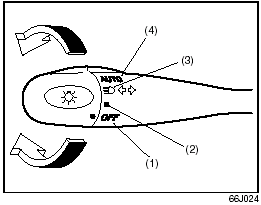
Lighting Operation
This control lever is located on the outboard side of the steering column. Operate the lever as described below. To turn the lights on or off, twist the knob on the end of the lever. There are four positions: in the “OFF” (1) position all lights are off; in the second (2) position the front parking lights, tail-lights, license plate light and instrument lights are on, but the headlights are off; in the third (3) position the headlights come on in addition to the other lights; in the “AUTO” (4) position, refer to “Auto-On Headlight System” for details.
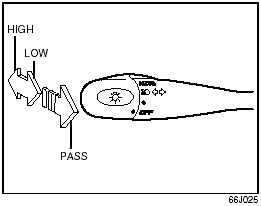
With the headlights on, push the lever forward to switch to the high beams or pull the lever toward you to switch to the low beams. When the high beams are on, a light on the instrument panel will come on. To momentarily activate the high beams as a passing signal, pull the lever slightly toward you and release it when you have completed the signal.
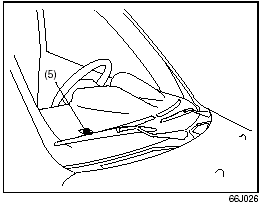
Auto-On Headlight
System
The Auto-on headlight system automatically turns on all lights that are operated by the lighting control lever on the steering column, when the following four conditions are all met. Conditions for Auto-on headlight system operation: 1) It is dark around the light sensor (5). 2) The lighting control lever in the “AUTO” position. 3) The ignition switch is in the “ON” position. 4) The parking brake is released. This system is operated by the signal from the light sensor (5) on the right end of the instrument panel. Do not cover the sensor (5). If you do, the system will not work correctly.
 WARNING: It takes about 5 seconds
for the light sensor to react to a change in lighting conditions. To help avoid
an accident due to reduced visibility, turn on your headlights before driving into
a tunnel, parking structure or the like.
WARNING: It takes about 5 seconds
for the light sensor to react to a change in lighting conditions. To help avoid
an accident due to reduced visibility, turn on your headlights before driving into
a tunnel, parking structure or the like.
NOTE: This system does not react to all types of ambient light. As the sensor is infrared type, it will not work correctly with ambient lights that do not contain infrared rays.
Daytime Running Light (D.R.L.) System
The headlights light, but are dimmer than the low beam, when the following three conditions are all met. Also, the D.R.L. indicator light on the instrument panel comes on. Conditions for D.R.L. system operation: 1) The engine is running. 2) The parking brake is released. 3) The lighting switch is in either the “OFF” or the “Second” position: or The lighting switch is in the “AUTO” position and it is light around the light sensor.
NOTE: Be sure to turn the lighting switch to the third position at night or at any time of the day when driving or weather conditions require the headlights to operate at full brightness and the taillights to be on.
Lights “On” reminder
A buzzer sounds to remind you to turn off the lights if they are left on when the ignition key is removed and the driver’s door is opened.
Turn Signal Operation
With the ignition switch in the “ON” position, move the lever up or down to activate the right or left turn signals.
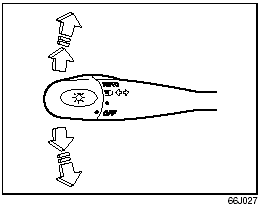
Normal turn signal
Move the lever all the way up to signal a right turn or all the way down to signal a left turn. When the turn is completed, the signal will cancel and the lever will return to its normal position.
Lane change signal
In some turns, such as changing lanes, the steering wheel is not turned far enough to cancel the turn signal. For convenience, you can flash the turn signal by moving the lever part way and holding it there. The lever will return to its normal position when you release it.
See also:
Inflatable Curtain (IC)
General information
This system consists of inflatable curtains
located along the sides of the roof liners,
stretching from the center of both front side
windows to the rear edge of the rear side door
windows. It is designed to help protec ...
Immobilizer system
Your vehicle is equipped with an electronic engine immobilizer system to reduce
the risk of unauthorized vehicle use. Your immobilizer system is comprised of a
small transponder in the ignition key, and antenna coil in the key cylinder and
Immo ...

 Ignition Switch
Ignition Switch